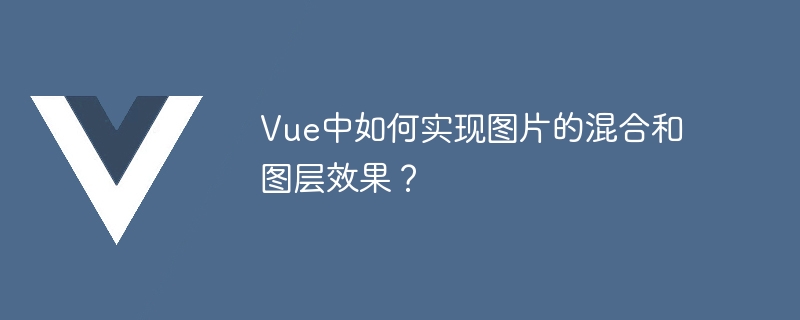Vue中如何实现图片的混合和图层效果?
- 王林原创
- 2023-08-18 11:05:131441浏览

Vue中如何实现图片的混合和图层效果?
在Web开发中,图片的混合和图层效果是创建吸引人的页面设计的重要元素之一。Vue作为一个流行的JavaScript框架,提供了强大的功能来实现这些效果。本文将介绍如何使用Vue来实现图片的混合和图层效果,并附上代码示例。
首先,我们需要使用Vue的组件来构建页面。创建一个新的Vue组件,命名为"ImageLayer"。
<template>
<div class="image-layer">
<img :src="imageSrc" class="background-image" alt="Vue中如何实现图片的混合和图层效果?" >
<div class="overlay-layer"></div>
</div>
</template>
<script>
export default {
name: 'ImageLayer',
data() {
return {
imageSrc: 'path/to/image.jpg'
}
}
}
</script>
<style scoped>
.image-layer {
position: relative;
width: 500px;
height: 300px;
}
.background-image {
width: 100%;
height: 100%;
}
.overlay-layer {
position: absolute;
top: 0;
left: 0;
width: 100%;
height: 100%;
background-color: rgba(0, 0, 0, 0.5);
}
</style>在上面的代码中,我们创建了一个包含背景图片和叠加图层的组件。背景图片通过:src属性来动态地绑定到imageSrc变量,你可以根据你的实际情况进行修改。叠加图层通过一个div元素来实现,使用position: absolute属性将其覆盖在背景图片上。:src属性来动态地绑定到imageSrc变量,你可以根据你的实际情况进行修改。叠加图层通过一个div元素来实现,使用position: absolute属性将其覆盖在背景图片上。
接下来,我们可以在需要使用图片混合和图层效果的地方引入这个Vue组件,并通过样式和绑定的数据来定制效果。
<template>
<div class="app">
<h1>图片混合和图层效果</h1>
<ImageLayer></ImageLayer>
</div>
</template>
<script>
import ImageLayer from './ImageLayer.vue'
export default {
name: 'App',
components: {
ImageLayer
}
}
</script>
<style>
.app {
text-align: center;
}
</style>在这个示例中,我们将ImageLayer组件引入到了一个名为App的父组件中。可以根据实际需求,在App组件中添加其他的HTML元素和样式,来呈现最终的页面效果。
当你在浏览器中运行这个Vue应用时,你将看到一个带有背景图片和叠加图层效果的页面。你可以通过修改ImageLayer
rrreee
在这个示例中,我们将ImageLayer组件引入到了一个名为App的父组件中。可以根据实际需求,在App组件中添加其他的HTML元素和样式,来呈现最终的页面效果。🎜🎜当你在浏览器中运行这个Vue应用时,你将看到一个带有背景图片和叠加图层效果的页面。你可以通过修改ImageLayer组件中的样式和绑定的数据,来自定义图片的混合和图层效果。🎜🎜总结一下,通过Vue和其强大的组件功能,我们可以轻松地实现图片的混合和图层效果。以上示例提供了一个简单的起点,你可以基于此进行进一步的定制和扩展。希望本文能帮助你在Vue中实现出色的页面设计!🎜以上是Vue中如何实现图片的混合和图层效果?的详细内容。更多信息请关注PHP中文网其他相关文章!
声明:
本文内容由网友自发贡献,版权归原作者所有,本站不承担相应法律责任。如您发现有涉嫌抄袭侵权的内容,请联系admin@php.cn

